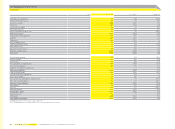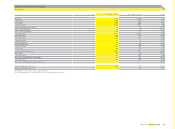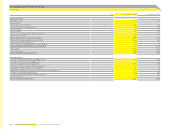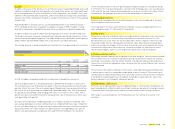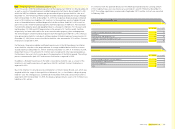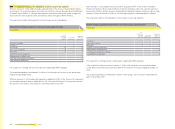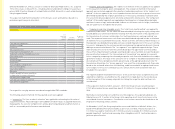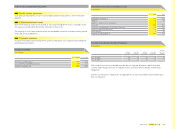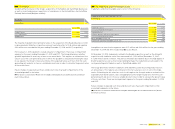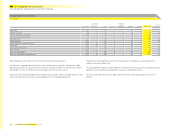Reebok 2008 Annual Report Download - page 166
Download and view the complete annual report
Please find page 166 of the 2008 Reebok annual report below. You can navigate through the pages in the report by either clicking on the pages listed below, or by using the keyword search tool below to find specific information within the annual report.
162 Consolidated Financial Statements Notes
Pensions and similar obligations
Provisions for pensions and similar obligations comprise the Group provision obligation under
defi ned benefi t and contribution plans. Obligations under defi ned benefi t plans are calculated
separately for each plan by estimating the benefi t amount that employees have earned in return
for their service during the current and prior periods. That benefi t is discounted to determine its
present value, and the fair value of any plan assets is deducted. The discount rate is the yield at
the balance sheet date on high-quality corporate bonds. Calculations are performed by qualifi ed
actuaries using the “projected unit credit method” in accordance with IAS 19. Obligations for
contributions to defi ned contribution plans are recognised as an expense in the income statement
when they are due.
As of January 1, 2005, due to application of the amendment to IAS 19 (“Employee Benefi ts”
issued in December 2004), the Group recognises actuarial gains or losses to defi ned benefi t
plans arising during the fi nancial year immediately outside the income statement in “other
reserves” within equity, as shown in the statement of recognised income and expense.
Recognition of revenues
Sales are recognised at the fair value of the consideration received or receivable, net of returns,
trade discounts and volume rebates, when the signifi cant risks and rewards of ownership of the
goods are transferred to the buyer, and when it is probable that the economic benefi ts associated
with the transaction will fl ow to the Group.
Royalty and commission income is recognised based on the contract terms on an accrual basis.
Advertising and promotional expenditures
Production costs for media campaigns are included in prepaid expenses (other current and
non-current assets) until fi nalised, and upon completion are expensed in full. Signifi cant
TV media buying costs are expensed over the original duration of the broadcast.
Promotional expenses that involve payments, including one-time up-front payments for promo-
tional contracts, are expensed systematically over the term of the agreement.
Interest
Interest is recognised as income or expense as incurred (using the “effective interest method”)
and is not capitalised.
Income taxes
Current income taxes are computed in accordance with the applicable taxation rules established
in the countries in which the Group operates.
The Group computes deferred taxes for all temporary differences between the carrying amount
and the tax base of its assets and liabilities and tax loss carry-forwards. As it is not permitted
to recognise a deferred tax liability for goodwill, the Group does not compute any deferred taxes
thereon.
Deferred tax assets arising from deductible temporary differences and tax loss carry-forwards
which exceed taxable temporary differences are only recognised to the extent that it is probable
that the company concerned will generate suffi cient taxable income to realise the associated
benefi t.
Income tax is recognised in the income statement except to the extent that it relates to items
recognised directly in equity, in which case it is recognised in equity.
Equity compensation benefi ts
Stock options were granted to members of the Executive Board of adidas AG as well as to the
managing directors /senior vice presidents of its affi liated companies and to further senior exec-
utives of the Group in connection with the Management Share Option Plan (MSOP) of adidas AG
see also Note 33. The Company has the choice to settle a potential obligation by issuing new
shares or providing the equivalent cash compensation. When options are exercised and the Com-
pany decides to issue new shares, the proceeds received net of any transaction costs are credited
to share capital and capital surplus. In the past, the Company has chosen to issue new shares. It
is planned to maintain this methodology in the future.
In accordance with IFRS 2, an expense and a corresponding entry to equity for equity-settled
stock options and an expense and a liability for cash-settled stock options is recorded.
The Group has applied IFRS 2 retrospectively and has taken advantage of the transitional provi-
sions of IFRS 2 with respect to equity-settled awards. As a result, the Group has applied IFRS 2
only to equity-settled awards granted after November 7, 2002, that had not yet vested on January
1, 2005 [Tranche V (2003)].
Estimation uncertainties
The preparation of fi nancial statements in conformity with IFRS requires the use of assumptions
and estimates that affect reported amounts and related disclosures. Although such estimates
are based on Management’s best knowledge of current events and actions, actual results may
ultimately differ from these estimates.
The key assumptions concerning the future and other key sources of estimation uncertainty
at the balance sheet date which have a signifi cant risk of causing a material adjustment to
the carrying amounts of assets and liabilities within the next fi nancial year are outlined in the
respective Notes, in particular goodwill see Note 11, trademarks see Note 12, provisions
see Note 16, pensions see Note 18, derivatives see Note 23 as well as deferred taxes
see Note 28.


